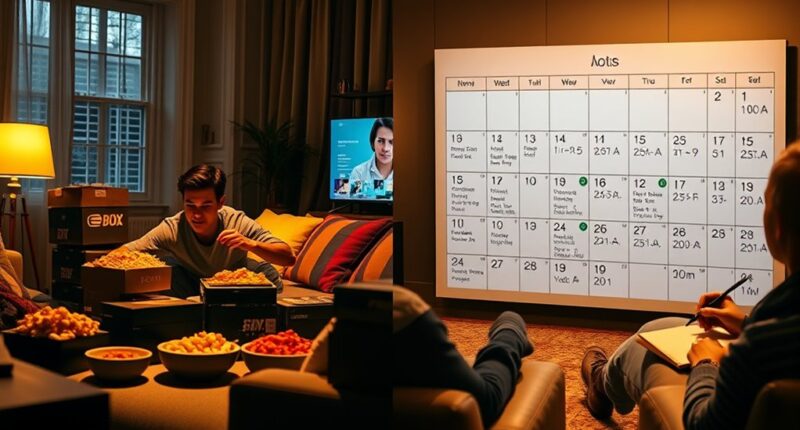If you prefer instant gratification, binge releases can give you quick emotional highs and deep immersion, but they might lead to fatigue or burnout over time. Weekly drops build anticipation, foster community, and allow you to savor storylines, reducing fatigue and boosting emotional engagement. The best model depends on your preferences and the type of content you enjoy. Keep exploring further to discover which approach aligns best with your viewing psychology.
Key Takeaways
- Binge-watching satisfies immediate gratification needs, fostering emotional highs and potential addiction, while weekly drops promote sustained anticipation and emotional engagement.
- Weekly releases enhance community interaction and discussion, strengthening social bonds, whereas bingeing often limits shared experiences.
- Binge-watching can impair memory retention of story details, while weekly drops support better recall and long-term engagement.
- Scarcity and exclusivity in weekly models increase anticipation and emotional investment, unlike binge releases which risk burnout and fatigue.
- Content type and audience demographics influence which model is more effective; thrillers benefit from weekly drops, while fast-paced genres suit bingeing.
The Rise of Streaming and Changing Consumption Habits
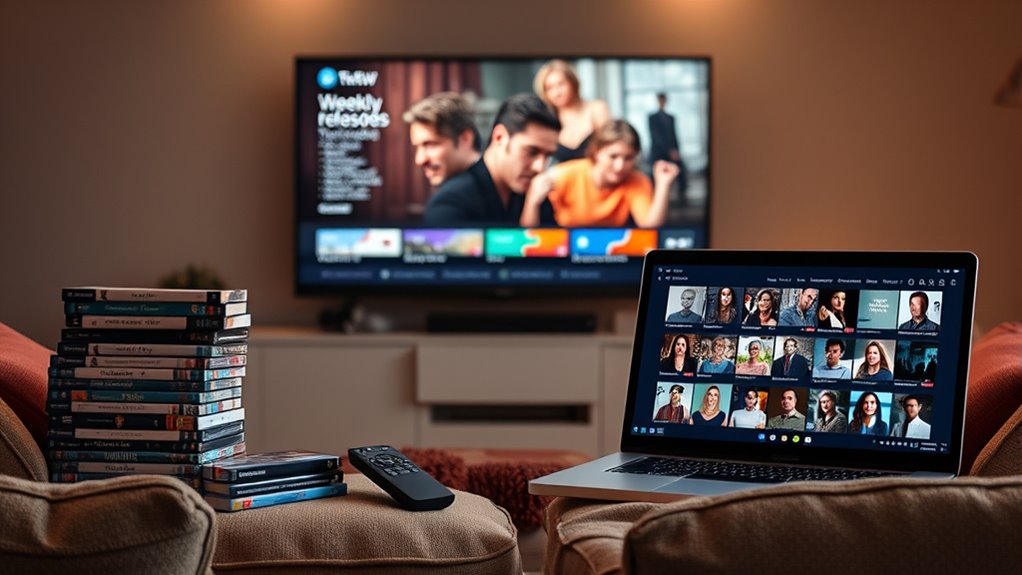
The rise of streaming platforms has revolutionized how people consume media, shifting away from traditional scheduled broadcasts. Now, you can watch what you want, when you want, fueling your viewer impulse to binge content without waiting. This change impacts release scheduling, which no longer follows fixed weekly installments but often drops entire seasons at once. With instant access, you’re encouraged to start a series and keep watching, driven by the desire for immediate gratification. This shift has altered viewing habits, making binge-watching more natural and appealing. Streaming platforms tailor their release strategies to match your impulse to consume content quickly, disrupting old habits of waiting for weekly episodes. As a result, your viewing experience becomes more fluid, flexible, and centered on your personal schedule. Additionally, AI-powered content recommendations further personalize your viewing experience, increasing your likelihood to binge-watch by suggesting related shows and movies tailored to your preferences.
Psychological Appeal of Binge-Watching
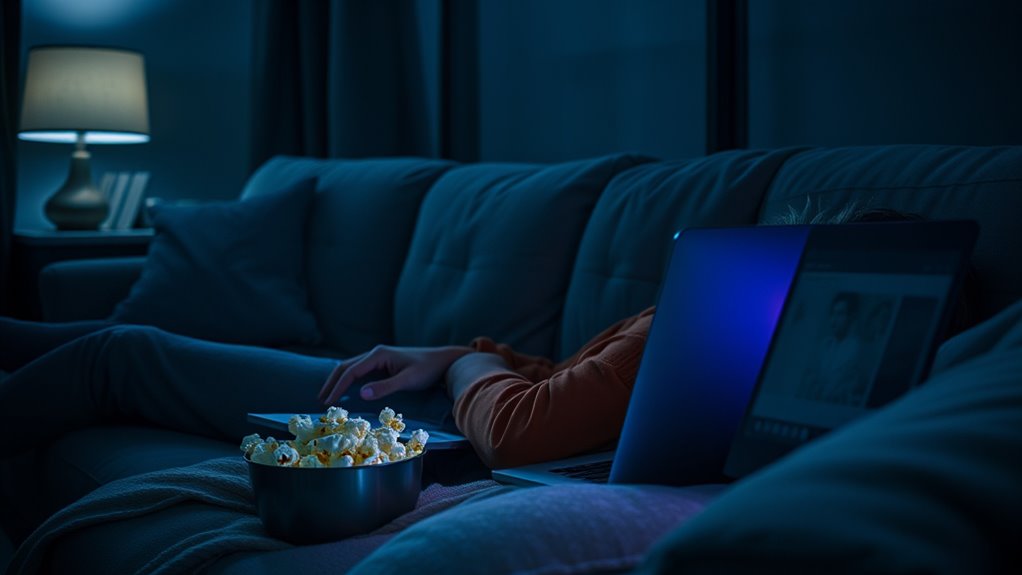
Binge-watching taps into your desire for immediate satisfaction, creating a sense of gratification that keeps you hooked. As you consume multiple episodes in one sitting, your emotional immersion deepens, making the story feel personal and intense. This continuous stream of content minimizes breaks, allowing you to stay fully engaged and lose track of time. The suspense buildup across episodes heightens your anticipation, fueling curiosity and emotional investment. You experience a rush of dopamine with each climax or twist, reinforcing the behavior. The ability to control how much you watch feeds your craving for instant reward, making the experience highly addictive. Overall, binge-watching satisfies your need for quick emotional highs and a sense of control, making it an appealing, psychologically driven viewing habit. Additionally, this behavior leverages your attention to detail and the brain’s reward system to create a compelling viewing experience.
The Anticipation Effect of Weekly Releases
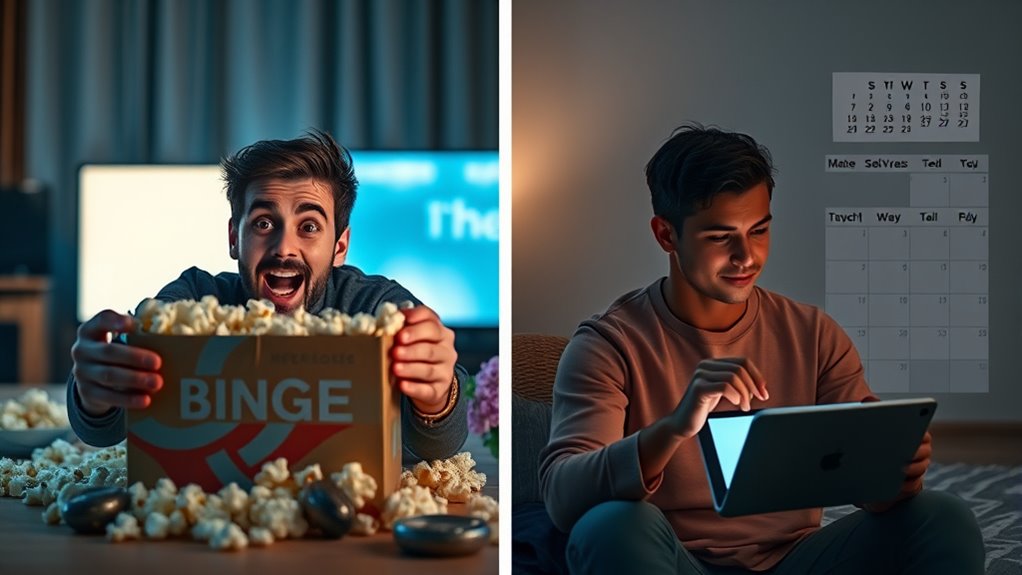
When shows release episodes weekly, you stay excited over a longer period instead of rushing through everything at once. This pacing builds ongoing anticipation and keeps you looking forward to each new installment. It also sparks conversations with others, creating a sense of community around the series. Additionally, the anticipation effect benefits from the high refresh rates of certain projectors, which help deliver smooth, immersive viewing experiences that enhance the enjoyment of each episode.
Builds Ongoing Excitement
Because new episodes are released weekly, viewers stay engaged over a longer period, enthusiastically anticipating each installment. This steady drip of content helps build ongoing excitement and keeps you keen for what’s next. The storytelling pacing in weekly releases creates natural peaks of anticipation, as each episode leaves you wanting more. Release timing plays an essential role, giving you time to process each story development while looking forward to the next chapter. This cycle of anticipation sustains your interest longer than binge-watching, where the story quickly unfolds. As each episode drops, you experience a gradual buildup of excitement that makes the overall viewing experience more memorable. This ongoing engagement encourages you to stay connected to the series over an extended period. Additionally, the ongoing appeal of weekly drops can foster a sense of community among viewers who discuss theories and share reactions between episodes.
Fosters Community Engagement
The weekly release schedule does more than just keep you enthusiastic for each episode; it also sparks lively conversations among viewers. This steady pace encourages fan loyalty, as audiences ardently await each installment and share their theories online. It fosters a sense of community where viewers bond over predictions and reactions. Plus, it offers viewing flexibility—you can savor each episode at your own pace without bingeing everything at once. This ongoing engagement keeps discussions alive longer, strengthening the connection between fans and the show. Here’s how weekly drops promote community engagement:
| Benefit | Effect | Key Aspect |
|---|---|---|
| Builds anticipation | Keeps conversations going | Fan loyalty |
| Encourages sharing | Creates shared experiences | Community bonding |
| Sustains interest | Extends engagement over time | Viewing flexibility |
Extends Viewer Anticipation
Have you noticed how weekly releases build a sense of excitement that lingers longer than binge-watching? The release frequency encourages you to wait and anticipate each episode, which tests and often enhances your viewer patience. Instead of consuming everything at once, you find yourself passionately counting down the days to the next drop. This extended anticipation keeps your interest alive over a longer period, making the experience more memorable. When shows release episodes weekly, they effectively stretch out the emotional journey, giving you time to reflect and discuss. This sustained engagement can deepen your connection to the story and characters. Moreover, building anticipation is a strategic approach that leverages psychological principles to keep viewers invested over time. Overall, the deliberate release schedule plays a significant role in extending viewer anticipation and maintaining ongoing excitement.
Impact on Memory and Recall of Storylines
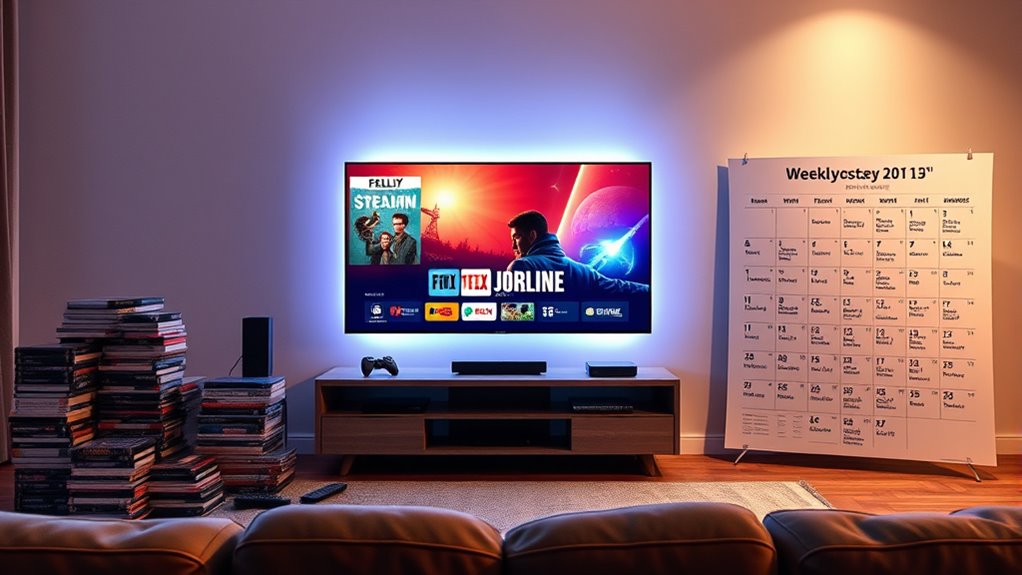
When viewers binge-watch an entire series at once, their ability to remember key storylines and character arcs can become muddled. This pattern often hampers memory retention and storyline recall over time. You might find it harder to distinguish important plot points or remember subtle character developments. To improve your memory of a series, consider these factors:
- Spacing out episodes helps reinforce key details.
- Reviewing episodes aids long-term recall.
- Taking notes highlights crucial plot points.
- Discussing the series with others boosts memory retention.
- Incorporating active engagement techniques can further enhance retention and understanding.
Binge-watching can lead to a quick immersion, but it may also cause details to blur, making it challenging to retain information for future reference. A steady release schedule encourages more effective storyline recall and deeper engagement.
Social Interaction and Community Building
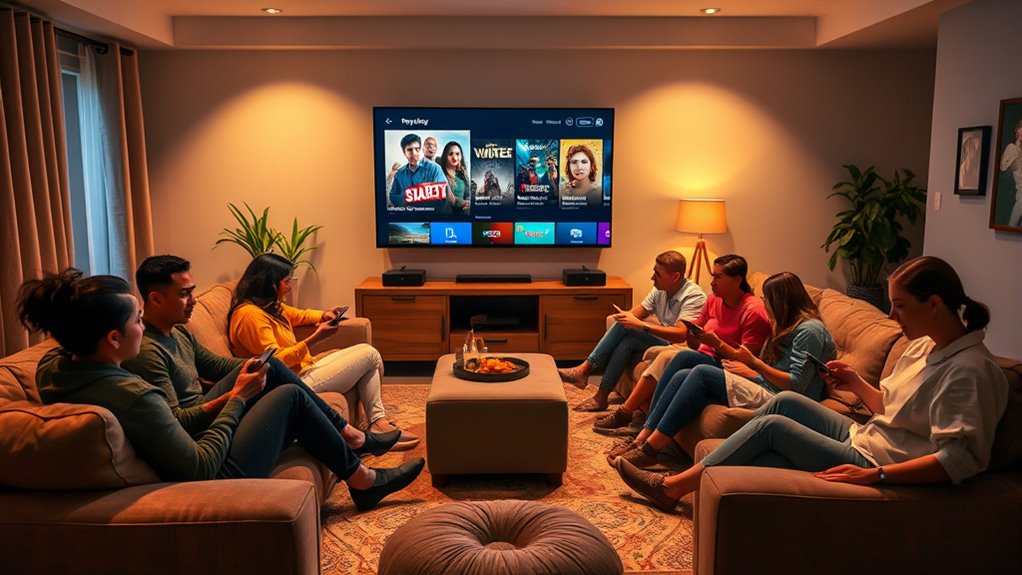
Binge-watching often leads to isolated viewing experiences, making it harder to connect with others who share your interests. When you consume an entire season quickly, you miss out on the everyday conversations and spontaneous discussions that foster community. Weekly drops, on the other hand, encourage you to visit online forums and social media regularly, where fans exchange fan theories, predictions, and insights. This ongoing engagement helps build a sense of community, as you join others in speculating about plot twists or character developments. The delayed gratification of weekly episodes keeps the conversation alive over a longer period, strengthening social bonds. Additionally, content engagement through social interaction enhances viewers’ emotional investment and satisfaction with the series. Ultimately, pacing your viewing influences how connected you feel to a larger fan community and the shared experience around the story.
Emotional Engagement and Viewer Satisfaction
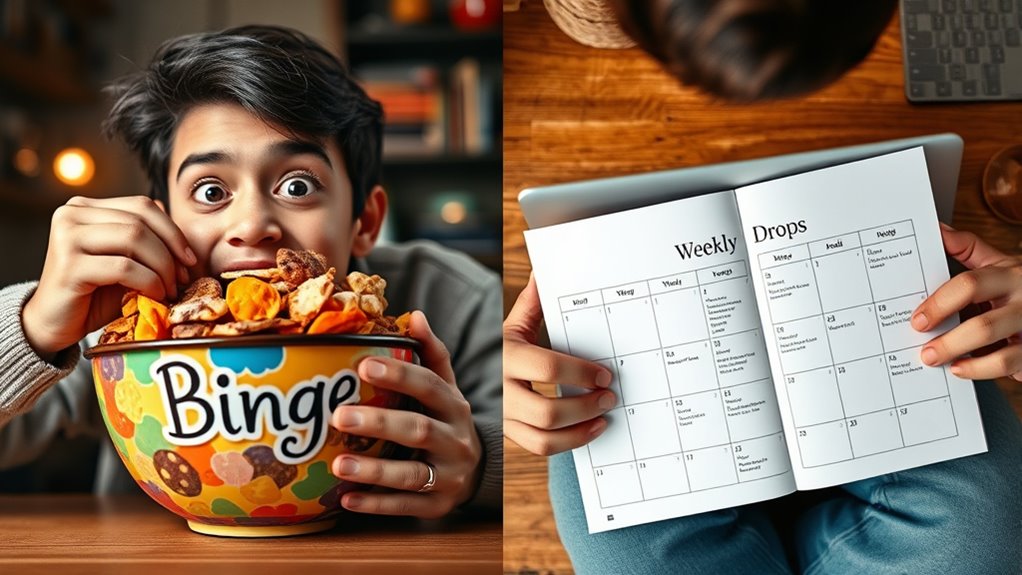
The way you consume a show markedly impacts your emotional connection and overall satisfaction. Binge-watching can deepen emotional investment quickly, leading to intense viewer loyalty. Alternatively, weekly drops allow for sustained anticipation and reflection, fostering a different kind of engagement. Consider these points:
- Immediate gratification versus prolonged suspense
- Building anticipation over time
- Emotional peaks and valleys
- Opportunities for community discussion
- The impact of content safety and how it influences viewer trust and comfort
Both models influence your emotional investment differently, affecting your overall satisfaction. Bingeing often creates a rush of emotions, but weekly releases encourage ongoing attachment and loyalty. The key is how each approach aligns with your viewing style and emotional needs. Ultimately, the model you prefer shapes your connection to the content and your loyalty to the series.
The Role of Scarcity and Exclusivity
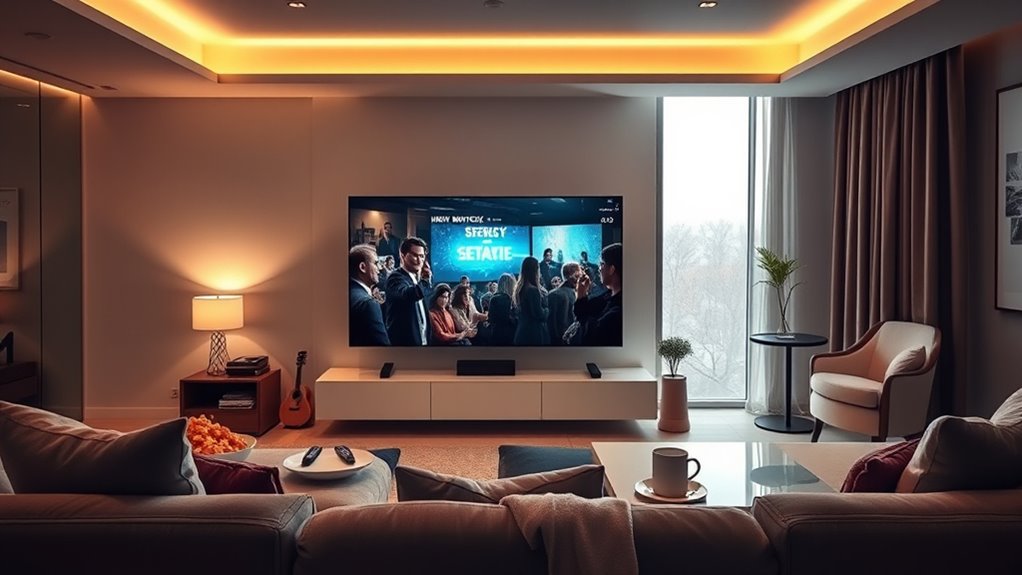
Scarcity and exclusivity profoundly shape how you value and engage with a series. When you’re offered exclusive access, it creates a sense of privilege that heightens your anticipation and emotional investment. Limited availability makes the content feel more special, encouraging you to tune in promptly rather than waiting. This sense of scarcity can boost your desire to experience the series firsthand, fostering a feeling of being part of something unique. Creators often leverage this by releasing episodes gradually or offering early access to select viewers. The idea of exclusivity taps into your need for status and belonging, making the viewing experience feel more rewarding. Interestingly, understanding the role of attention in creative practice shows that full focus can enhance your appreciation of exclusive content. Ultimately, scarcity and exclusivity drive engagement by making the series seem more valuable and urgent.
Effects on Viewer Fatigue and Burnout
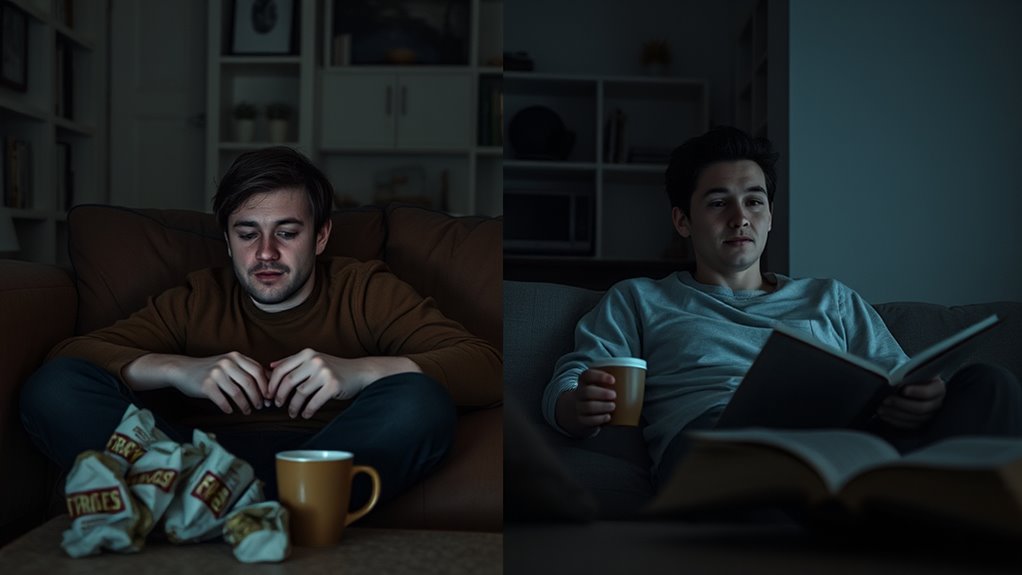
When you binge-watch, you might feel overwhelmed by instant gratification overload, leaving you exhausted quickly. On the other hand, waiting week to week can build prolonged anticipation stress, making each release feel more intense. Both approaches can lead to content binge consequences, impacting your overall well-being.
Instant Gratification Overload
As more streaming platforms adopt the binge model and release entire seasons at once, viewers often find themselves overwhelmed by the constant influx of content. This instant gratification overload fuels a desire for rapid consumption, which can lead to fatigue and burnout. When you can binge-watch endlessly, you may feel pressured to keep up with the fast consumption speed, sacrificing your well-being. Consider these effects:
- Shortened attention spans
- Increased anxiety over missing out
- Reduced satisfaction from slow-paced storytelling
- Heightened craving for immediate rewards
This endless stream of content encourages instant gratification, making it difficult to pause and reflect. Over time, this can drain your mental energy, leaving you exhausted and less able to enjoy media intentionally.
Prolonged Anticipation Stress
Prolonged anticipation of new episodes or seasons can create ongoing stress that wears you down over time. With release scheduling, you find yourself constantly waiting, which tests your viewer patience. The longer the wait, the more you may feel anxious or frustrated, leading to fatigue. This sustained anticipation can diminish your enjoyment, making watching feel like a chore rather than a pleasure. Instead of avidly awaiting each new drop, you might start to dread the gaps between releases. Over time, this stress can contribute to burnout, reducing your overall engagement with the content. The unpredictability of release schedules keeps you on edge, and if your patience wears thin, you might stop caring altogether. This cycle of prolonged anticipation ultimately takes a toll on your viewing experience.
Content Binge Consequences
Constantly waiting for new episodes can lead you to binge entire seasons in one sitting, which might seem like a good way to catch up. However, this content overload can cause significant viewing fatigue and burnout. When you binge, your brain processes a flood of storylines, emotions, and visuals all at once, making it hard to retain information or stay engaged. Over time, this can diminish your enjoyment and lead to mental exhaustion. Consider these effects:
- Reduced emotional impact of story arcs
- Increased overall fatigue and frustration
- Decreased motivation to watch future episodes
- Heightened risk of burnout from constant consumption
Binge-watching might feel satisfying initially, but it often results in long-term consequences for your mental well-being.
Choosing the Right Model for Different Content Types
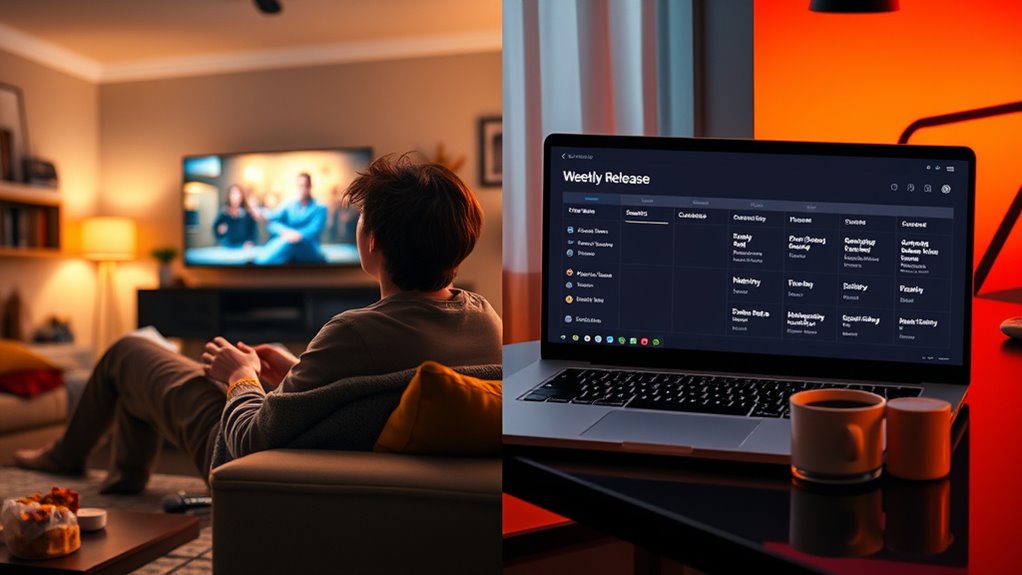
Choosing the right release model depends heavily on the type of content you produce and your audience’s preferences. For genres with complex storylines, like thrillers or dramas, weekly drops can build anticipation and encourage ongoing engagement. If your audience is older or prefers deeper storytelling, a weekly schedule supports immersion and discussion. Conversely, for fast-paced genres like comedy or reality TV, binge releases cater to viewers seeking immediate gratification. Consider your audience demographics: younger viewers often prefer bingeing, while niche or dedicated fans may appreciate weekly releases for sustained conversation. Matching your content’s genre compatibility with your audience’s viewing habits ensures better engagement. Additionally, implementing a consistent release schedule can help establish viewer expectations and loyalty, especially when using Cold-Pressed Vegetable Juice techniques to keep your content fresh and appealing. Ultimately, selecting the right model aligns your content type with viewer psychology, maximizing reach and satisfaction.
Frequently Asked Questions
How Does Release Timing Influence Viewer Loyalty?
Release timing markedly impacts viewer loyalty by affecting viewership consistency and audience retention. When content drops weekly, you’re more likely to stay engaged, building anticipation and routine. Conversely, binge releases might lead to rapid viewership spikes but can cause drop-offs afterward. By understanding this, you can choose a timing strategy that keeps you consistently interested, fostering a stronger connection with the content and encouraging ongoing loyalty.
What Are the Long-Term Effects of Binge-Watching on Mental Health?
Binge-watching can negatively impact your mental health and emotional well-being, especially if it leads to sleep deprivation or social isolation. You might experience increased anxiety, mood swings, or burnout over time. To protect your mental health, it’s important to set limits, take breaks, and balance screen time with other activities. Remember, moderation helps maintain your emotional well-being and prevents long-term negative effects.
Do Different Genres Favor One Release Model Over the Other?
Different genres often favor specific release models based on viewer preferences and demographics. For example, high-intensity genres like thrillers or dramas may benefit from weekly drops, keeping viewers engaged over time. Conversely, binge-worthy genres like comedy or action might thrive with full-season releases, appealing to those who prefer instant gratification. Understanding your genre and target viewers helps determine the best release strategy, boosting engagement and satisfaction.
How Do Cultural Differences Impact Viewer Preferences for Release Styles?
Cultural differences shape your preferences for release styles through unique viewing habits and regional content preferences. In some cultures, you might prefer weekly drops, building anticipation and discussion, while others favor binge-watching to enjoy stories in one sitting. Your regional content exposure influences how you engage with releases, making the choice of model a reflection of your cultural viewing habits. These differences ultimately impact how you consume and enjoy content.
What Role Does Platform Algorithm Play in Shaping Viewer Engagement?
The platform algorithm plays a pivotal role in shaping your engagement by influencing what content you see first. It uses engagement strategies to keep you hooked, recommending shows based on your viewing habits. This algorithm influence can boost binge-watching or encourage weekly drops, depending on how it’s designed. By tailoring content to your preferences, the platform aims to maximize your time spent and enjoyment, ultimately shaping your viewing experience.
Conclusion
Ultimately, whether you prefer binge-watching or weekly drops depends on your viewing style. Studies show that 60% of viewers find weekly releases build more excitement and community. If you crave anticipation and meaningful discussions, weekly drops might suit you better. But if instant gratification is your thing, binge-watching satisfies that need. Understanding your habits helps you choose the model that keeps your entertainment fresh and engaging—so pick what works best for you.
